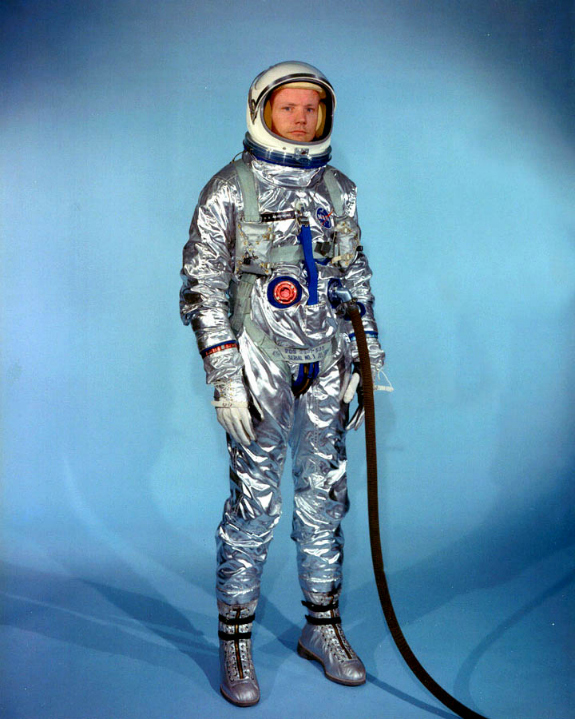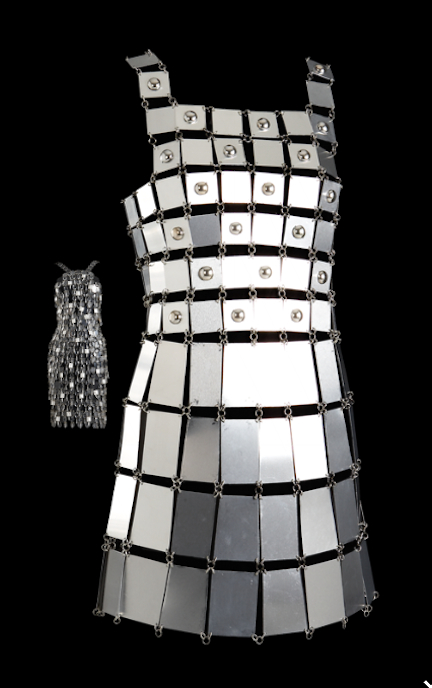What Did Playtex Have to Do With Neil Armstrong?
The astronaut’s lunar outfit was designed by the women’s bra manufacturer and inspired a series of space age fashions
![]()

Pressure suit, A7-L worn by Armstrong. Materials for the overalls include beta cloth, rubber, nylon, plastic connectors, aluminum neck ring, aluminum wrist locking rings, aluminum zipper and brass with neoprene gasket.
“A spacesuit is made out of a flight suit, a Goodrich tire, a bra, a girdle, a raincoat, a tomato worm.”
From the book Spacesuit: Fashioning Apollo, by Nicholas de Monchaux
Or, that’s what a spacesuit was made from in 1969 when astronaut Neil Armstrong, who died this past weekend, donned the bulky, Pillsbury-Doughboy-looking suit of great engineering and design ingenuity to take humankind’s first steps on the moon.
A spacesuit is “the world’s smallest spacecraft,” explained MIT professor, engineer and spacesuit designer Dava Newman at the PopTech conference in 2011. This pressurized outerwear, designed for human survival in space, has to provide an astronaut with protection against the extreme environment, deliver oxygen, modulate temperature and equally important, allow mobility for the wearer to work.
Over 300 spacesuits, including the one Armstrong wore on the Apollo 11 mission, are in the Smithsonian collection at the National Air and Space Museum. They are lovingly cared for, conserved and covered in muslin (to absorb the hydrochloric acid the suits emit) at a Smithsonian storage facility outside of Washington, D.C. And they require a lot of care. As Amanda Young, the former conservator for these suits and author of Spacesuits: The Smithsonian National Air and Space Museum Collection, explained by Smithsonian in 2010, they were designed to withstand extreme conditions “for a short period but it turns out they can resist nothing for a long period of time.”
The evolution of the spacesuit has been one of trial and error, nixing skin-tight, multilayered garments that took a team to get on and off, as well as individualized, pressurized rolling balloon structures. But Armstrong’s handmade, completely customized suit (complete with an American flag stitched on the shoulder), the first garment to touch the surface the moon, was a product of the industrial division of the women’s bra manufacturer Playtex. The L.A. Review of Books, in reviewing Spacesuit: Fashioning Apollo, described how, as underdogs, the Playtex team secured the contract with their innovative-thinking, couture-level sewing skills and sheer determination:
ILC’s team , a motley group of seamstresses and engineers, led by a car mechanic and a former television repairman, manages to convince NASA to let them enter their “test suit” in a closed, invitation-only competitive bid at their own expense. They spend six weeks working around the clock—at times breaking into their own offices to work 24-hour shifts—to arrive at a suit solution that starkly outperforms the two invited competitors. In open, direct competition with larger, more moneyed companies, ILC manages to produce a superior space suit by drawing on the craft-culture handiwork and expertise of seamstresses, rather than on the hard-line culture of engineering.
Playtex’s design and construction, seen by millions after Armstrong made his lunar landing, brought space age fashion collections to a frenzied pitch in the late 1960s. Designers had been toying with styles for a few years in anticipation of the moon landing. Spearheaded by designers Paco Rabanne, Pierre Cardin and Andre Courreges, their far-out interpretations of garments-of-the-future became all the rage.
Today, with the future of NASA’s space program uncertain, we look back on those retro futuristic fashions with wistful nostalgia. But, with the enormously exciting success of the Curiosity roving on Mars and people like Richard Branson planning intergalactic vacations, we need to continue innovating on what we’ll wear in the cosmos. Dava Newman is at the forefront, working on a “bio-suit” that will work like a second skin in space.
Shorts: Dava Newman’s streamlined flight suit from PopTech on Vimeo.
To learn more about what we may be wearing on Mars and check out a prototype of her team’s design, watch this short video from PopTech. I imagine Armstrong would’ve been moonwalking like Michael Jackson if he’d been wearing one of these.
/https://tf-cmsv2-smithsonianmag-media.s3.amazonaws.com/accounts/headshot/emily-spivack-240.jpg)


/https://tf-cmsv2-smithsonianmag-media.s3.amazonaws.com/accounts/headshot/emily-spivack-240.jpg)